Evaluating the Activity of Pigs with Radio-Frequency Identification and Virtual Walking Distances
Abstract
:Simple Summary
Abstract
1. Introduction
2. Materials and Methods
2.1. Animals, Research Barn and Technical Equipment
2.2. Virtual Walking Distance
3. Results
4. Discussion
5. Conclusions
Author Contributions
Funding
Institutional Review Board Statement
Informed Consent Statement
Data Availability Statement
Acknowledgments
Conflicts of Interest
Appendix A
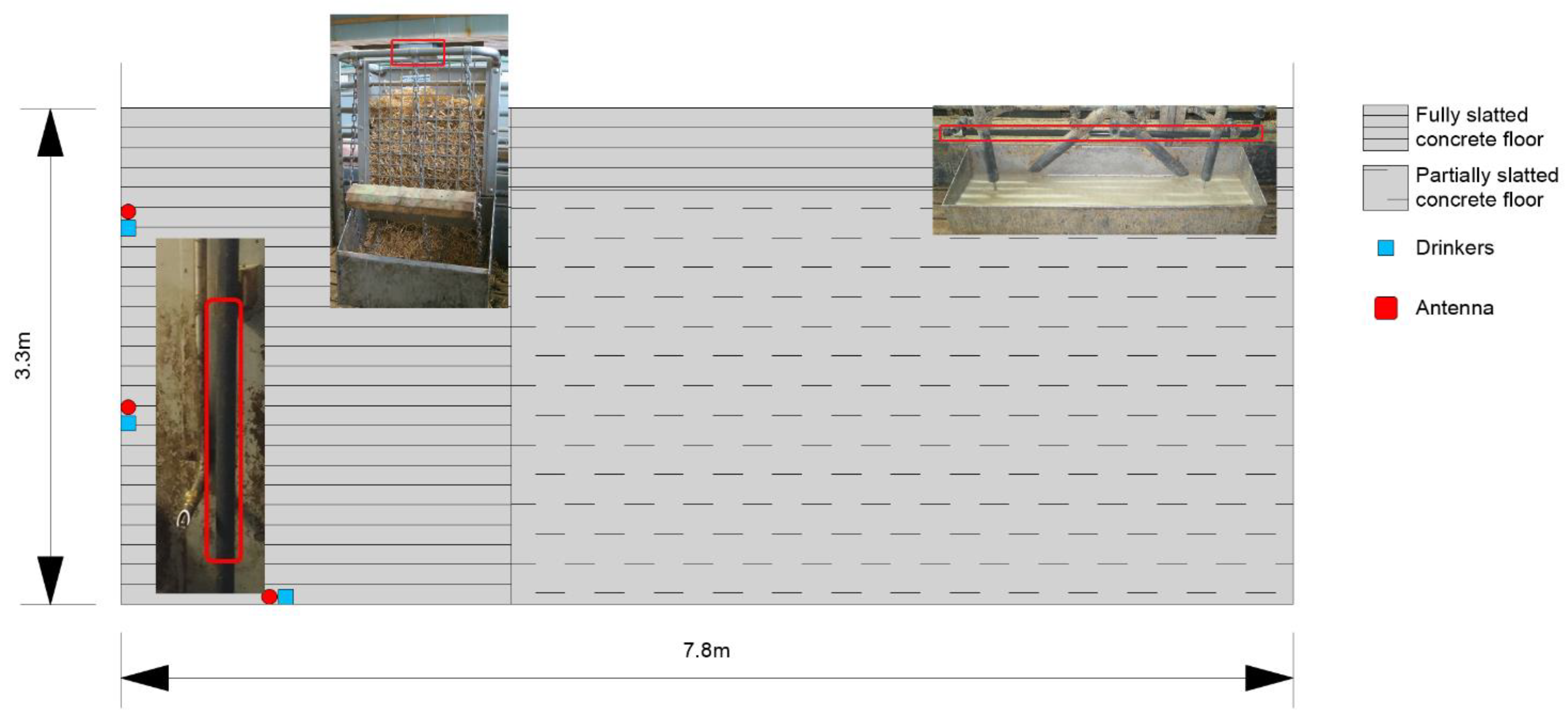

References
- Matthews, S.G.; Miller, A.L.; Clapp, J.; Plötz, T.; Kyriazakis, I. Early detection of health and welfare compromises through automated detection of behavioural changes in pigs. Vet. J. 2016, 217, 43–51. [Google Scholar] [CrossRef] [PubMed]
- Cornou, C.; Lundbye-Christensen, S. Classifying sows’ activity types from acceleration patterns: An application of the Multi-Process Kalman Filter. Appl. Anim. Behav. Sci. 2008, 111, 262–273. [Google Scholar] [CrossRef]
- Gonzalez, L.A.; Tolkamp, B.J.; Coffey, M.P.; Ferret, A.; Kyriazakis, I. Changes in feeding behavior as possible indicators for the automatic monitoring of health disorders in dairy cows. J. Dairy. Sci. 2008, 91, 1017–1028. [Google Scholar] [CrossRef] [PubMed]
- Bornett, H.L.I.; Morgan, C.A.; Lawrence, A.B.; Mann, J. The flexibility of feeding patterns in individually housed pigs. Anim. Sci. 2000, 70, 457–469. [Google Scholar] [CrossRef]
- Coutellier, L.; Arnould, C.; Boissy, A.; Orgeur, P.; Prunier, A.; Veissier, I.; Meunier-Salaün, M.-C. Pig’s responses to repeated social regrouping and relocation during the growing-finishing period. Appl. Anim. Behav. Sci. 2007, 105, 102–114. [Google Scholar] [CrossRef]
- Scheel, C.; Traulsen, I.; Auer, W.; Müller, K.; Stamer, E.; Krieter, J. Detecting lameness in sows from ear tag-sampled acceleration data using wavelets. Animal 2017, 11, 2076–2083. [Google Scholar] [CrossRef]
- Meijer, E.; Oosterlinck, M.; van Nes, A.; Back, W.; van der Staay, F.J. Pressure mat analysis of naturally occurring lameness in young pigs after weaning. BMC Vet. Res. 2014, 10, 193. [Google Scholar] [CrossRef]
- Grégoire, J.; Bergeron, R.; D’Allaire, S.; Meunier-Salaün, M.-C.; Devillers, N. Assessment of lameness in sows using gait, footprints, postural behaviour and foot lesion analysis. Animal 2013, 7, 1163–1173. [Google Scholar] [CrossRef]
- Chapinal, N.; de Passillé, A.M.; Rushen, J.; Wagner, S. Automated methods for detecting lameness and measuring analgesia in dairy cattle. J. Dairy. Sci. 2010, 93, 2007–2013. [Google Scholar] [CrossRef]
- Blackie, N.; Amory, J.; Bleach, E.; Scaife, J. The effect of lameness on lying behaviour of zero grazed Holstein dairy cattle. Appl. Anim. Behav. Sci. 2011, 134, 85–91. [Google Scholar] [CrossRef]
- Pastell, M.; Kujala, M.; Aisla, A.-M.; Hautala, M.; Poikalainen, V.; Praks, J.; Veermäe, I.; Ahokas, J. Detecting cow’s lameness using force sensors. Comput. Electron. Agric. 2008, 64, 34–38. [Google Scholar] [CrossRef]
- Traulsen, I.; Breitenberger, S.; Auer, W.; Stamer, E.; Müller, K.; Krieter, J. Automatic detection of lameness in gestating group-housed sows using positioning and acceleration measurements. Animal 2016, 10, 970–977. [Google Scholar] [CrossRef] [PubMed]
- Nalon, E.; Conte, S.; Maes, D.; Tuyttens, F.A.M.; Devillers, N. Assessment of lameness and claw lesions in sows. Livest. Sci. 2013, 156, 10–23. [Google Scholar] [CrossRef]
- Van Nuffel, A.; Zwertvaegher, I.; Pluym, L.; van Weyenberg, S.; Thorup, V.M.; Pastell, M.; Sonck, B.; Saeys, W. Lameness detection in dairy cows: Part 1. How to distinguish between non-lame and lame cows based on differences in locomotion or behavior. Animals 2015, 5, 838–860. [Google Scholar] [CrossRef]
- Podgórski, T.; Baś, G.; Jędrzejewska, B.; Sönnichsen, L.; Śnieżko, S.; Jędrzejewski, W.; Okarma, H. Spatiotemporal behavioral plasticity of wild boar (Sus scrofa) under contrasting conditions of human pressure: Primeval forest and metropolitan area. J. Mammal. 2013, 94, 109–119. [Google Scholar] [CrossRef]
- Morelle, K.; Podgórski, T.; Prévot, C.; Keuling, O.; Lehaire, F.; Lejeune, P. Towards understanding wild boar Sus scrofa movement: A synthetic movement ecology approach. Mamm. Rev. 2015, 45, 15–29. [Google Scholar] [CrossRef]
- Johann, F.; Handschuh, M.; Linderoth, P.; Heurich, M.; Dormann, C.F.; Arnold, J. Variability of daily space use in wild boar Sus scrofa. Wildl. Biol. 2020, 2020, 1–12. [Google Scholar] [CrossRef]
- Gustafsson, M.; Jensen, P.; de Jonge, F.H.; Schuurman, T. Domestication effects on foraging strategies in pigs (Sus scrofa). Appl. Anim. Behav. Sci. 1999, 62, 305–317. [Google Scholar] [CrossRef]
- Junge, M. Verhaltens- und Gesundheitsmonitoring für die Gruppenhaltung Tragender Sauen. Ph.D. Thesis, Universität Hohenheim, Stuttgart, Germany, 2015. [Google Scholar]
- Brendle, J.; Hoy, S. Investigation of distances covered by fattening pigs measured with VideoMotionTracker®. Appl. Anim. Behav. Sci. 2011, 132, 27–32. [Google Scholar] [CrossRef]
- Will, M.K.; Büttner, K.; Kaufholz, T.; Müller-Graf, C.; Selhorst, T.; Krieter, J. Accuracy of a real-time location system in static positions under practical conditions: Prospects to track group-housed sows. Comput. Electron. Agric. 2017, 142, 473–484. [Google Scholar] [CrossRef]
- Benjamin, M.; Yik, S. Precision livestock farming in swine welfare: A review for swine practitioners. Animals 2019, 9, 133. [Google Scholar] [CrossRef] [PubMed]
- Martínez-Avilés, M.; Fernández-Carrión, E.; López García-Baones, J.M.; Sánchez-Vizcaíno, J.M. Early detection of infection in pigs through an online monitoring system. Transbound. Emerg. Dis. 2017, 64, 364–373. [Google Scholar] [CrossRef] [PubMed]
- Schenck, E.L.; McMunn, K.A.; Rosenstein, D.S.; Stroshine, R.L.; Nielsen, B.D.; Richert, B.T.; Marchant-Forde, J.N.; Lay, D.C. Exercising stall-housed gestating gilts: Effects on lameness, the musculo-skeletal system, production, and behavior. J. Anim. Sci. 2008, 86, 3166–3180. [Google Scholar] [CrossRef]
- Lind, N.M.; Vinther, M.; Hemmingsen, R.P.; Hansen, A.K. Validation of a digital video tracking system for recording pig locomotor behaviour. J. Neurosci. Methods 2005, 143, 123–132. [Google Scholar] [CrossRef]
- Adrion, F.; Kapun, A.; Eckert, F.; Holland, E.-M.; Staiger, M.; Götz, S.; Gallmann, E. Monitoring trough visits of growing-finishing pigs with UHF-RFID. Comput. Electron. Agric. 2018, 144, 144–153. [Google Scholar] [CrossRef]
- Hammer, N.; Adrion, F.; Staiger, M.; Holland, E.; Gallmann, E.; Jungbluth, T. Comparison of different ultra-high-frequency transponder ear tags for simultaneous detection of cattle and pigs. Livest. Sci. 2016, 187, 125–137. [Google Scholar] [CrossRef]
- Kapun, A.; Adrion, F.; Gallmann, E. Case study on recording pigs’ daily activity patterns with a UHF-RFID system. Agriculture 2020, 10, 542. [Google Scholar] [CrossRef]
- Stäbler, R.; Patzkéwitsch, D.; Reese, S.; Erhard, M.; Hartmannsgruber, S. Behavior of domestic pigs under near-natural forest conditions with ad libitum supplementary feeding. J. Vet. Behav. 2022, 48, 20–35. [Google Scholar] [CrossRef]
- Hoy, S. Verhalten der Schweine. In Nutztierethologie; Hoy, S., Ed.; Verlag Eugen Ulmer: Stuttgart, Germany, 2009; pp. 105–139. ISBN 9783825233129. [Google Scholar]
- Häußermann, A. Stallklimaregelung und Emissionen—Entwicklung und Evaluierung sensorgestützter komplexer Regelstrategien für die Mastschweinehaltung. Ph.D. Thesis, Universität Hohenheim, Stuttgart, Germany, 2006. [Google Scholar]
- Van der Zande, L.E.; Guzhva, O.; Rodenburg, T.B. Individual detection and tracking of group housed pigs in their home pen using computer vision. Front. Anim. Sci. 2021, 2, 669312. [Google Scholar] [CrossRef]
- Larsen, M.L.V.; Wang, M.; Norton, T. Information technologies for welfare monitoring in pigs and their relation to Welfare Quality®. Sustainability 2021, 13, 692. [Google Scholar] [CrossRef]
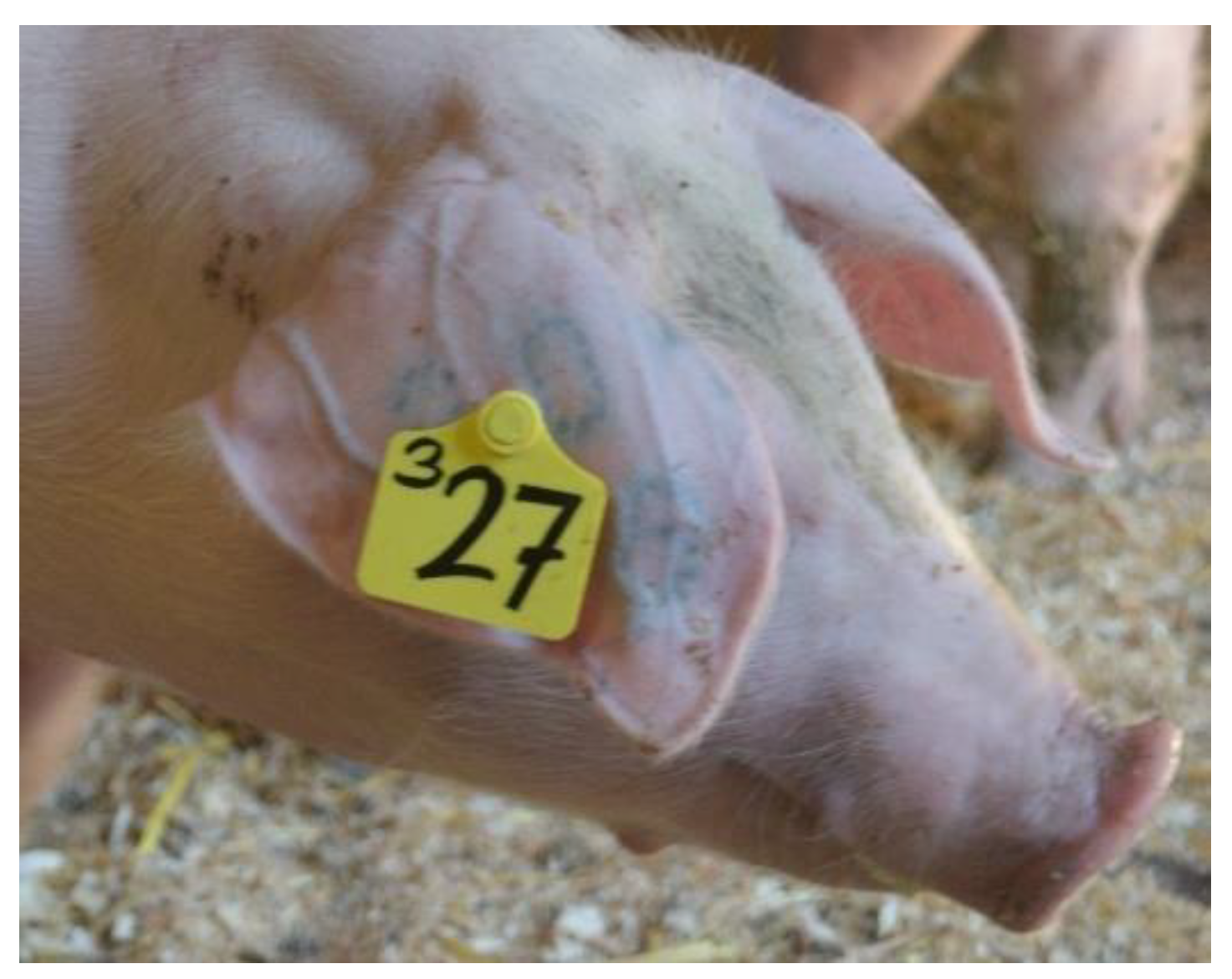

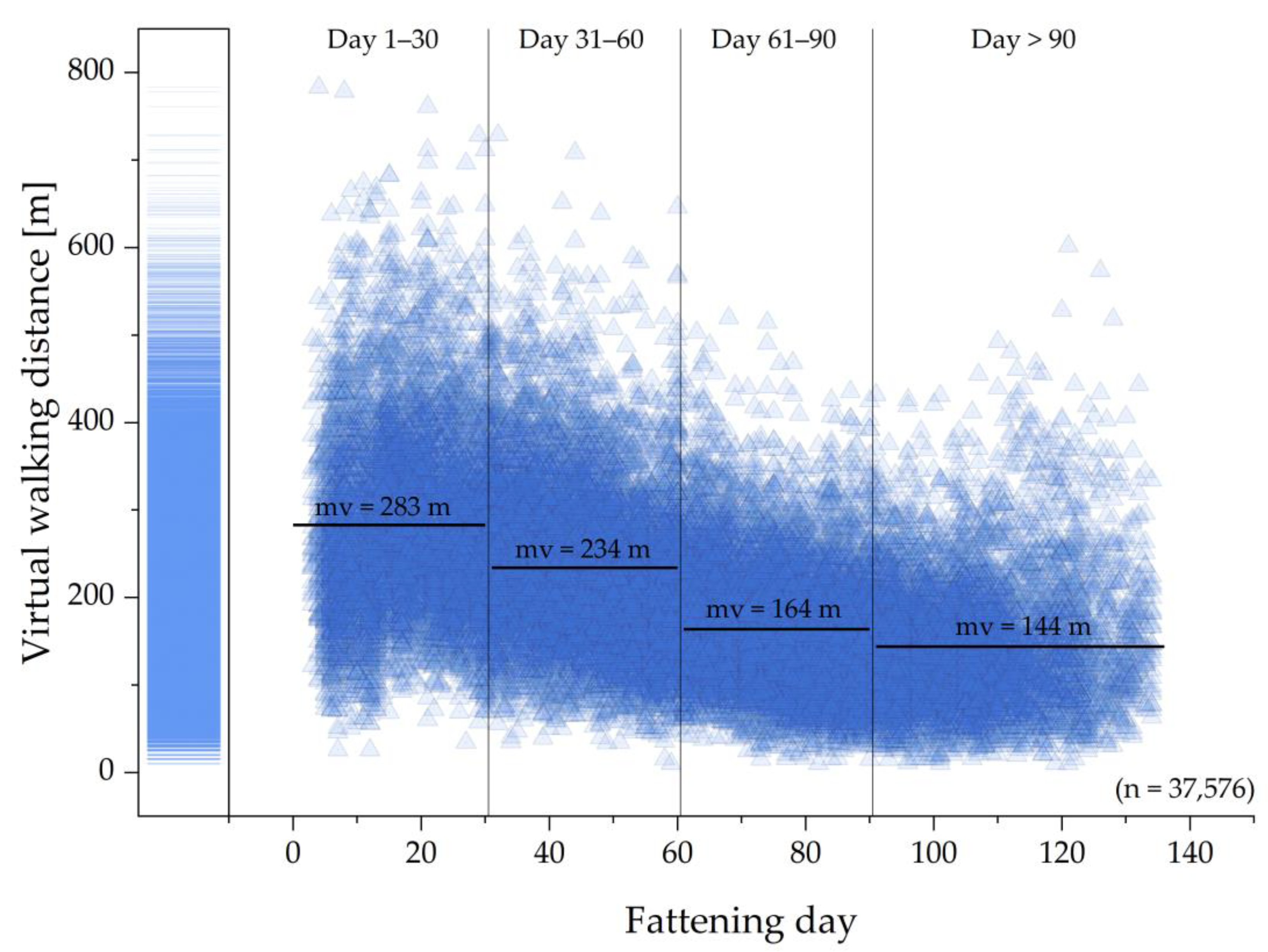
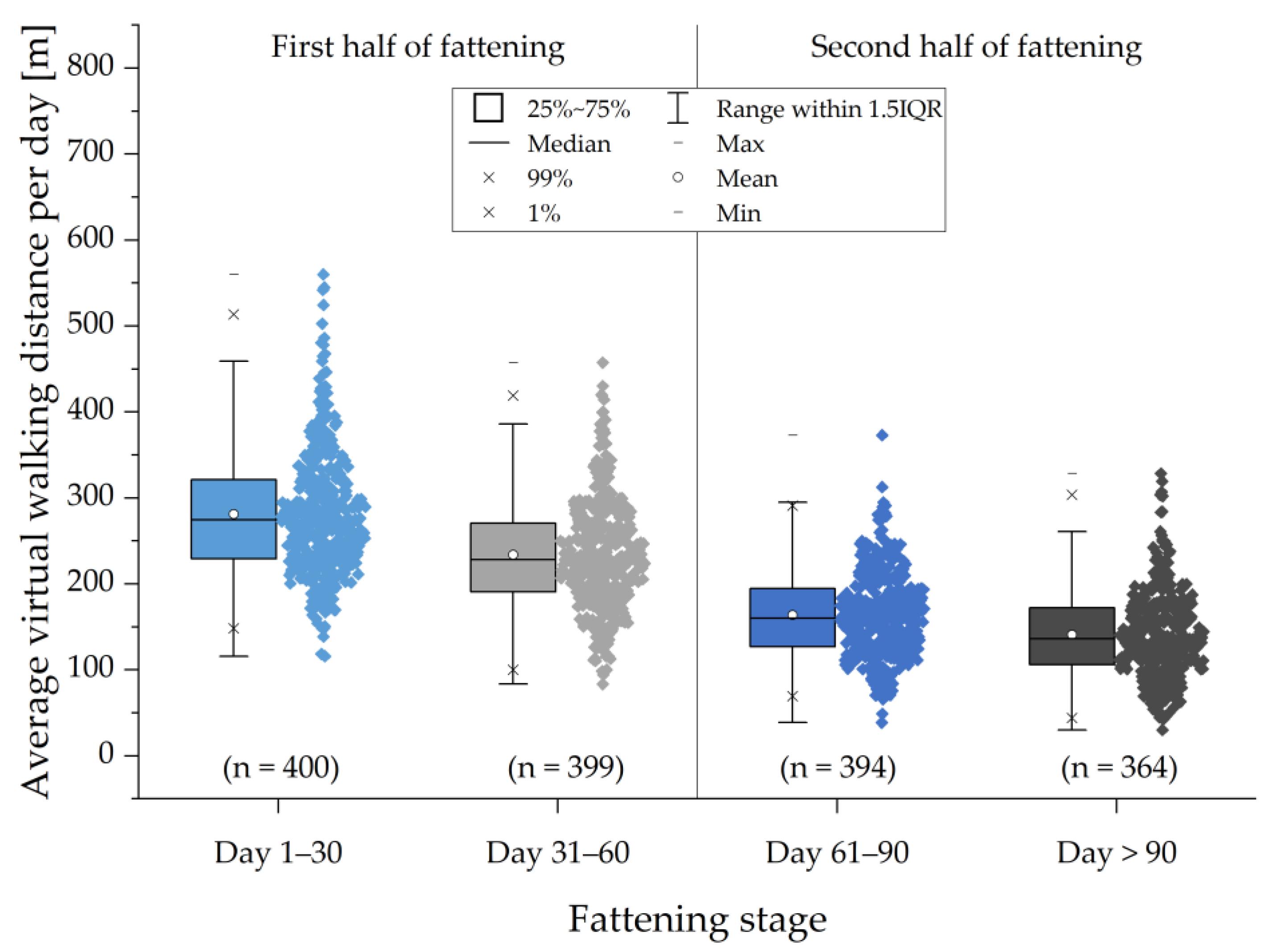

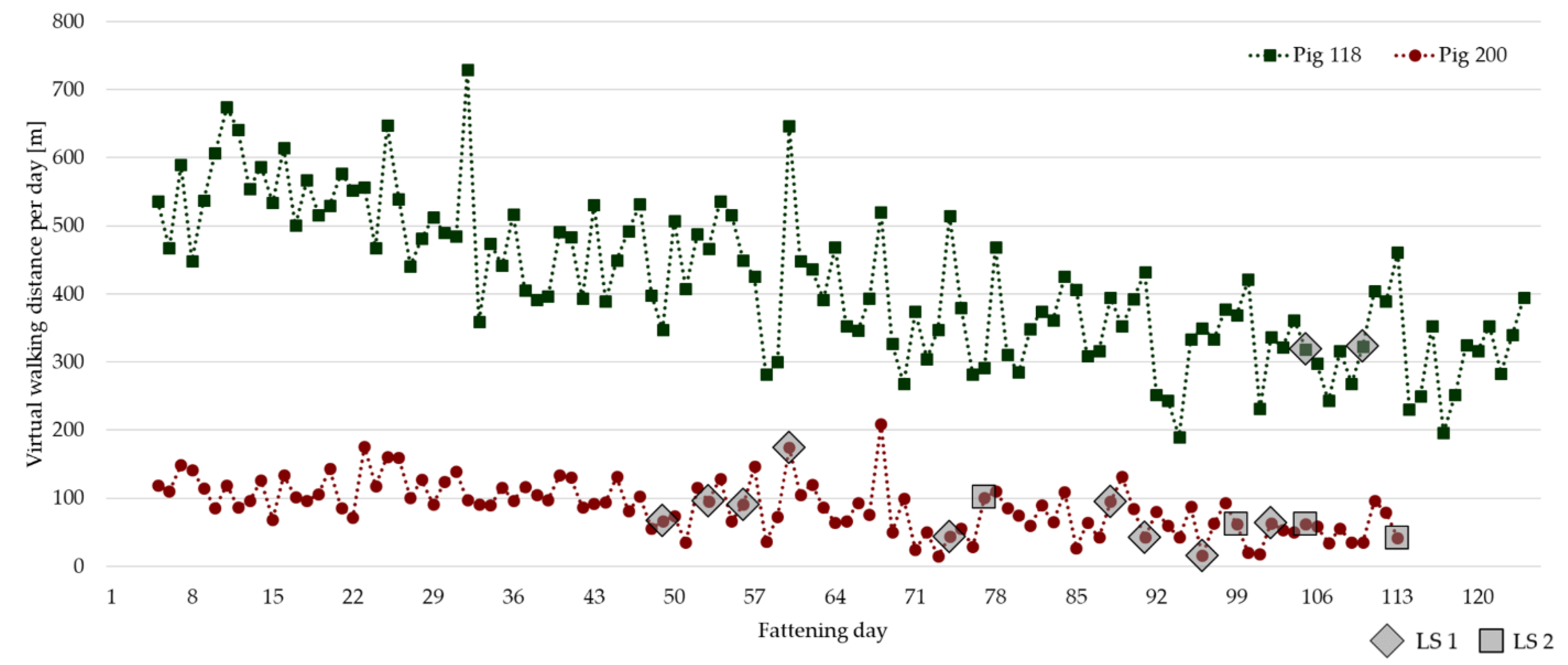
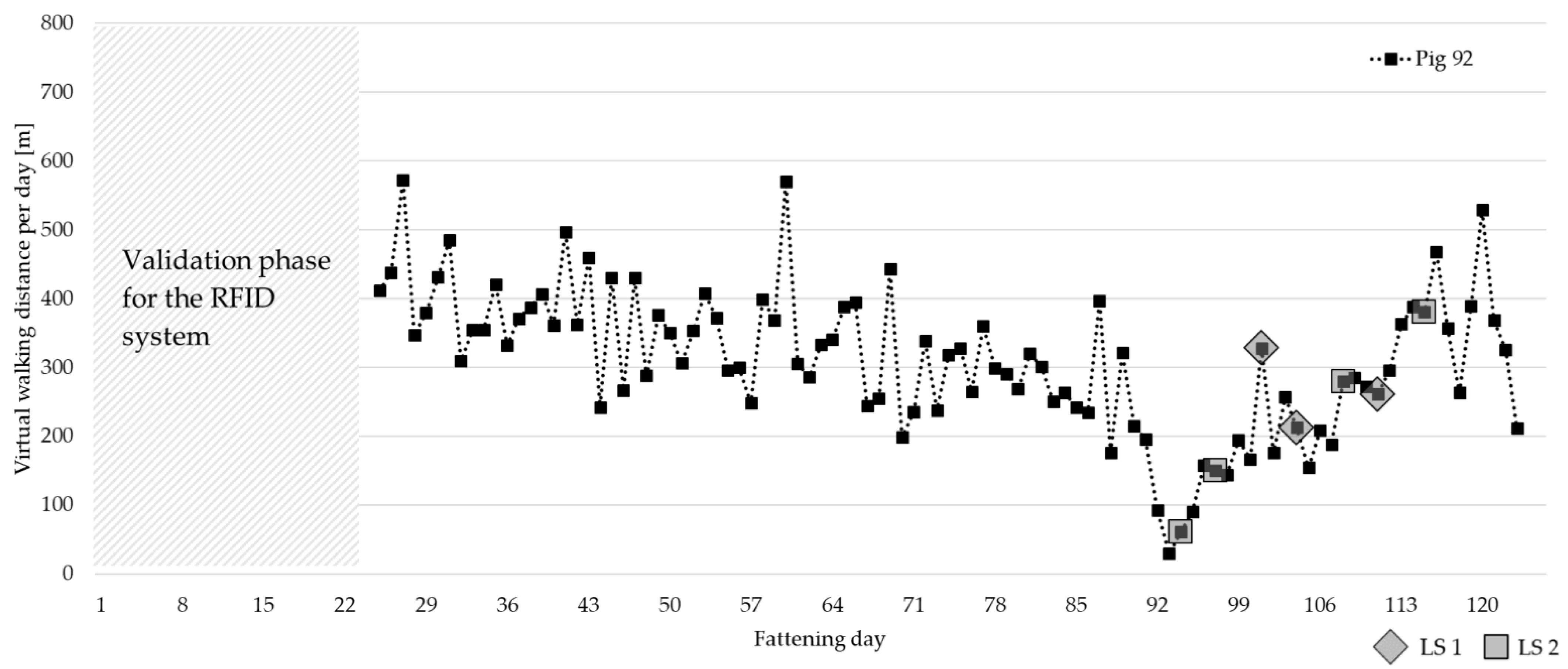
| Fattening Period | Pen | Average Starting Weight of the Pigs (kg) | Compartment | Average Daily Temperature (°C) | Average Daily Relative Humidity (%) |
|---|---|---|---|---|---|
| Fattening period 1 (Aug–Dec 16) | Pen 1 | 32.5 ± 2.9 | C1 | 20.0 ± 4.3 | 55.8 ± 6.1 |
| Pen 2 | 27.5 ± 2.5 | ||||
| Pen 3 | 32.6 ± 2.3 | C2 | 20.1 ± 4.2 | 54.0 ± 6.4 | |
| Pen 4 | 27.3 ± 1.5 | ||||
| Fattening period 2 (Jan–May 17) | Pen 1 | 31.9 ± 3.9 | C1 | 18.7 ± 1.6 | 47.7 ± 7.6 |
| Pen 2 | 36.0 ± 3.1 | ||||
| Pen 3 | 33.1 ± 3.4 | C2 | 18.4 ± 1.4 | 46.3 ± 8.6 | |
| Pen 4 | 31.7 ± 3.1 | ||||
| Fattening period 3 (Jun–Oct 17) | Pen 1 | 29.2 ± 1.9 | C1 | 22.6 ± 3.8 | 57.7 ± 7.5 |
| Pen 2 | 31.1 ± 2.8 | ||||
| Pen 3 | 27.6 ± 1.7 | C2 | 22.1 ± 3.7 | 57.4 ± 6.3 | |
| Pen 4 | 32.6 ± 2.5 | ||||
| Fattening period 4 (Jul–Nov 18) | Pen 1 | 27.3 ± 3.1 | C1 | 21.1 ± 4.3 | 52.5 ± 6.0 |
| Pen 2 | 27.0 ± 2.5 | ||||
| Pen 3 | 34.3 ± 2.9 | C2 | 21.6 ± 4.4 | 54.7 ± 6.6 | |
| Pen 4 | 25.2 ± 1.8 |
| Trough | Drinker 1 | Drinker 2 | Drinker 3 | Playing Device | |
|---|---|---|---|---|---|
| Trough | – | 7.0 m | 7.5 m | 7.3 m | 5.2 m |
| Drinker 1 | – | 1.6 m | 2.7 m | 3.0 m | |
| Drinker 2 | – | 1.3 m | 2.6 m | ||
| Drinker 3 | – | 2.1 m | |||
| Playing Device | – |
Disclaimer/Publisher’s Note: The statements, opinions and data contained in all publications are solely those of the individual author(s) and contributor(s) and not of MDPI and/or the editor(s). MDPI and/or the editor(s) disclaim responsibility for any injury to people or property resulting from any ideas, methods, instructions or products referred to in the content. |
© 2023 by the authors. Licensee MDPI, Basel, Switzerland. This article is an open access article distributed under the terms and conditions of the Creative Commons Attribution (CC BY) license (https://creativecommons.org/licenses/by/4.0/).
Share and Cite
Kapun, A.; Adrion, F.; Gallmann, E. Evaluating the Activity of Pigs with Radio-Frequency Identification and Virtual Walking Distances. Animals 2023, 13, 3112. https://doi.org/10.3390/ani13193112
Kapun A, Adrion F, Gallmann E. Evaluating the Activity of Pigs with Radio-Frequency Identification and Virtual Walking Distances. Animals. 2023; 13(19):3112. https://doi.org/10.3390/ani13193112
Chicago/Turabian StyleKapun, Anita, Felix Adrion, and Eva Gallmann. 2023. "Evaluating the Activity of Pigs with Radio-Frequency Identification and Virtual Walking Distances" Animals 13, no. 19: 3112. https://doi.org/10.3390/ani13193112
APA StyleKapun, A., Adrion, F., & Gallmann, E. (2023). Evaluating the Activity of Pigs with Radio-Frequency Identification and Virtual Walking Distances. Animals, 13(19), 3112. https://doi.org/10.3390/ani13193112






